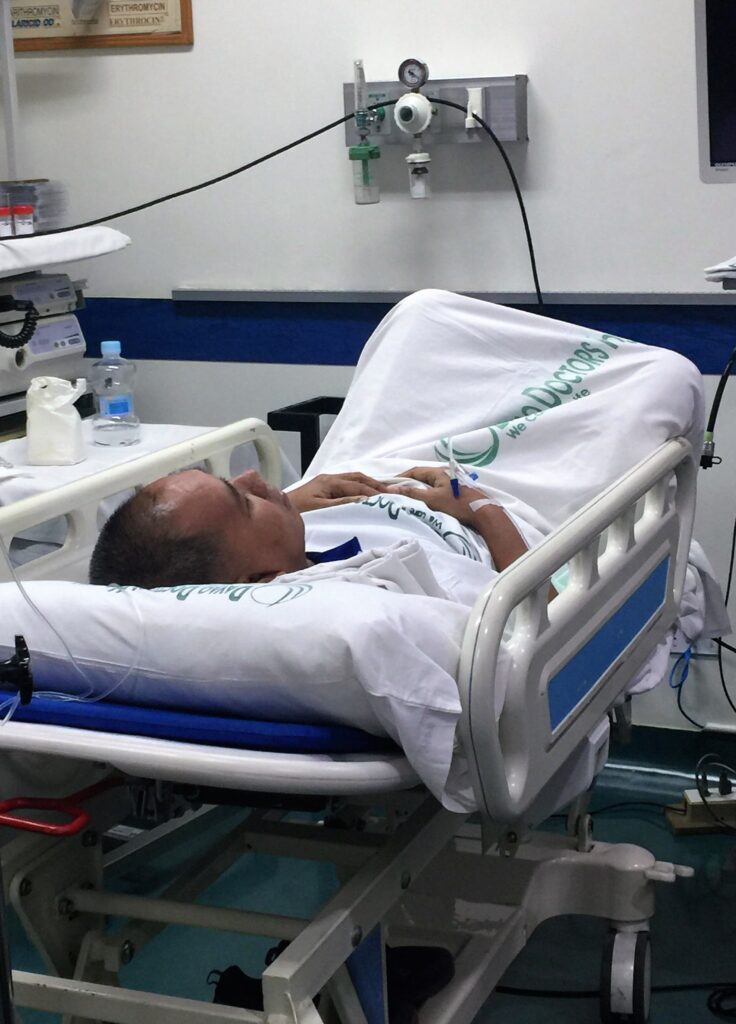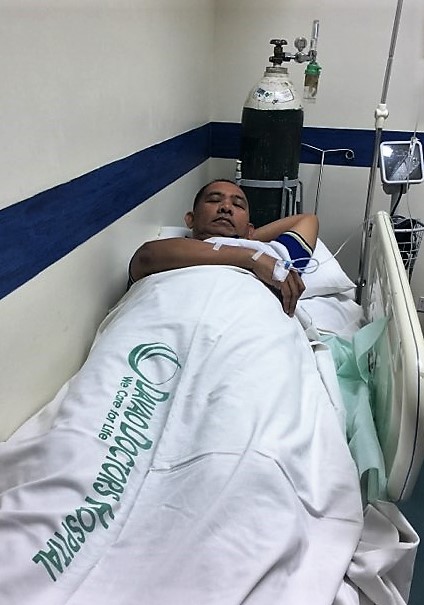SO, YOU WANT TO UNDERGO COLONOSCOPY?
By Henrylito D. Tacio
Photos by Evangeline T. Capuno
“Colonoscopy saves lives,” Dr. James McKinnell, a university assistant professor who also works at the Los Angeles BioMed Research Institute in California, was quoted as saying by an international news dispatch. “The benefit is a reduction in the risk of death (from colon cancer).”
Colon cancer is the fourth most common form of cancer among Filipinos – after breast, lung, and liver cancers. Among those who died of colon cancer include president Corazon C. Aquino, actor Charlie Davao, and singers Susan Fuentes and Roel Cortez.
“Among cancers, colon cancer stands out as a disease that can be largely prevented, but few people believe it will happen to them,” said Dr. Atenodoro Ruiz, Jr., a gastroenterology consultant at St. Luke’s Medical Center and a diplomate of the American Board of Internal Medicine in Gastroenterology and of the Philippine College of Physicians in Internal Medicine.
“If it is still in early-stage and localized within the colon, the cure is 100 percent,” said Dr. Ruiz. “If it had spread to lymph nodes or distant organs, the 5-year survival rate is much lower.”
Dr. Aaron I. Velasco, an internist, and gastroenterologist who works in various hospitals in Davao City added that the 5-year survival rate of those diagnosed with stage 1 colon cancer is 92%. It goes down to 63-80% for those with stage 2 and 50% with stage 3. The chance of survival of those diagnosed with stage 4 is very minimal: 11%.

Better safe than sorry. “Many colorectal cancers can be prevented through regular screening,” cancercare.org says. “Screening can find precancerous polyps – abnormal growths in the colon or rectum – so that they can be removed before they turn into cancer. Screening is crucial because when found early, colorectal cancer is highly treatable.”
Dr. Ruiz recommends that colon cancer screening among Filipinos should start at age 50. And colonoscopy is the best screening test available for colon cancer. It is an examination used to detect changes or abnormalities in the large intestine (colon) and rectum.
“In a colonoscopy,” explains Dr. Velasco, “we use a tube with a tiny camera to look at the whole colon and rectum. We don’t only find tumors early, but the test can also prevent colorectal cancer by removing polyps.”
I came to know Dr. Velasco because he was the person who performed a colonoscopy on me. If you are wondering why I had to undergo the procedure, here are the reasons: I am more than 50 years old and I had this feeling to need a bowel movement that is not relieved by doing so. In addition, I observed the narrowing of my stool which lasted for more than a few days.
The early stages of colon cancer usually present no symptoms, but they tend to appear as cancer progresses. But those I felt were possible symptoms, which also include diarrhea, constipation, or other change in bowel habits; blood (either bright red or very dark) in the stool; unexplained anemia; abdominal pain and tenderness in the lower abdomen; intestinal obstruction; weight loss with no known reason; feeling very tired; and vomiting.
“The most common first symptom of rectal cancer is bleeding during a bowel movement,” says The Merck Manual of Medical Information. “Painful bowel movement and a feeling that the rectum has not been completely emptied are other symptoms of rectal cancer. Sitting may be painful, but otherwise, the person usually feels no pain from cancer itself unless it spreads to tissue outside the rectum.”
I told Dr. Ruiz, who happens to be my friend, about my situation. He suggested that I undergo a colonoscopy. When I inquired about possible complications, he replied, “You will be sedated so there is no pain. Don’t worry.”

A colonoscopy usually takes 30 to 45 minutes, according to Dr. Velasco. However, in some instances, it may take longer, depending upon what is found and what is done during the test.
Before a colonoscopy, he advised me to clean out (empty) my colon. One day before the procedure, he told me to take general liquids all throughout the day. “You must consume 3-4 liters of fluids like water and juices,” he said. “For breakfast, you can eat porridge. Lunch is all noodles and dinner will only be just soup.”
That’s not all. I had to drink an oral solution laxative twice: at 8 am and then at 3 pm. At 8 in the evening, I took four tablets of Senokot. After two in the morning the following day, he advised me not to take anything.
On the day of my colonoscopy, I took two Dulcolax tablets at 5 am. An hour later, I had my anti-hypertensive medicine. Both tablets were taken with only a small sip of water.
I had my schedule at 9:30 in the morning so together with my sister, Evangeline T. Capuno, we went to the hospital an hour earlier. There was one ahead of us at the hospital endoscopy unit. When the nurse saw me, she asked me what brought me there. I told her the reason. She then asked me to sign a consent form authorizing the procedure.
After that, she asked me to go with her and told me to wear the hospital gown. She returned to the room after I had done changing my clothes and asked me to lie down in a bed and placed dextrose in my right hand.
It was past 10 when I was finally inside the screening room. They placed some devices all over my body, including a plastic nasal tube into my nose to provide extra oxygen during the procedure. To monitor the amount of oxygen in my blood, a small device was placed on my right fingers. My blood pressure was also monitored.
I was asked to lie on my side on the exam table with my knees drawn toward my chest. Then, Dr. Philip Valencia, the anesthesiologist, told me, “Sir, I have to let you sleep now.” He then proceeded to give general anesthesia through an intravenous line to induce unconsciousness on me during the whole process.
True enough, I was sleeping when colonoscopy was done on me. Here’s what happens while the patient is sleeping, according to the Mayo Clinic: “The doctor will insert a colonoscope into your rectum. The scope — which is long enough to reach the entire length of your colon — contains a light and a tube (channel) that allows the doctor to pump air or carbon dioxide into your colon. The air or carbon dioxide inflates the colon, which provides a better view of the lining of the colon. When the scope is moved or air is introduced, you may feel abdominal cramping or the urge to have a bowel movement.
“The colonoscope also contains a tiny video camera at its tip. The camera sends images to an external monitor so that the doctor can study the inside of your colon. The doctor can also insert instruments through the channel to take tissue samples (biopsies) or remove polyps or other areas of abnormal tissue.”
After 30 minutes or so, I was awakened by Dr. Valencia. “Sir, wake up,” he told me. “It’s done.”
Colonoscopy is very safe but some doctors caution there is a slight chance for problems from a colonoscopy. The scope or a small tool may tear the lining of the colon or cause bleeding. This must be the reason why WebMd.com suggests that those who undergo colonoscopy should call their doctor immediately if, after the test, they: have heavy rectal bleeding, have severe belly pain, develop a fever, are very dizzy, are vomiting, and have a swollen and firm belly.
Aside from colonoscopy, other screening tests for colon cancer include barium enema X-rays, sigmoidoscopy, stool tests, and computed tomographic colonography. Which screening test you choose depends on your risk, your preference, and your doctor. “Be sure to talk to your doctor about what puts you at risk and what test is best for you,” Dr. Velasco reminds.
If you are wondering what the result of my colonoscopy was, here’s the report: “The procedure was done under IV sedation with no untoward complication. Greenish, watery fecal material was seen over the sigmoid colon and the descending colon, which was removed by saline flushing and suctioning. The cecal pole was reached; unremarkable mucosa from the cecum/ileocecal valve down to the rectosigmoid colon save for a few, diminutive polyps seen over the rectum/distal sigmoid, removed by cold biopsy forceps. Incidental finding of dilated venous columns above the dentate line.”
In simpler terms, it’s negative!
What if, it was positive? According to the Mayo Clinic, a colonoscopy is considered positive if the doctor finds any polyps or abnormal tissue in the colon. Depending on the size and number of polyps, you may need to follow a more rigorous surveillance schedule in the future to look for more polyps.
“If your doctor finds one or two polyps less than 0.4 inch (1 centimeter) in diameter, he may recommend a repeat colonoscopy in five to 10 years, depending on your other risk factors for colon cancer,” the Mayo Clinic states.
A doctor will recommend another colonoscopy sooner if the patient has more than two polyps; a large polyp (larger than 0.4 inches); polyps and also residual stool in the colon that prevents complete examination of the colon; polyps with certain cell characteristics that indicate a higher risk of future cancer; and cancerous polyps.
There are some patients who may find the cost of a colonoscopy expensive. In my case, the total bill was almost P30,000. After deducting about P12,000 from Philippine Health Insurance, I had to pay more or less P18,000.
“A stool test called the Fecal Immunochemical Test (FIT) is a good screening alternative,” Dr. Ruiz says. “FIT detects only human blood and is specific for bleeding in the colon. The test is repeated every year if the initial test is negative. If the test is positive, a colonoscopy is needed to rule out the presence of cancer.”
Other screening tests that can be performed include sigmoidoscopy, double-contrast barium enema, virtual colonoscopy, and DNA stool tests. But these tests are not as thorough as a colonoscopy. If polyps or tumors are suspected based on these tests, you will still need to have a colonoscopy.
As stated earlier, colon cancer is treatable when discovered early. But if cancer has already invaded other tissues, it may be too late.
On January 20, 1993, Oscar-winning actress Audrey Hepburn died of colon cancer in Tolochenaz, Vaud, Switzerland at the age of 63. Emmy-winning American comedian and actor Milton Berle was told he had a cancerous colon tumor in 2001 but he refused surgery; he died in Los Angeles, California the following year.

